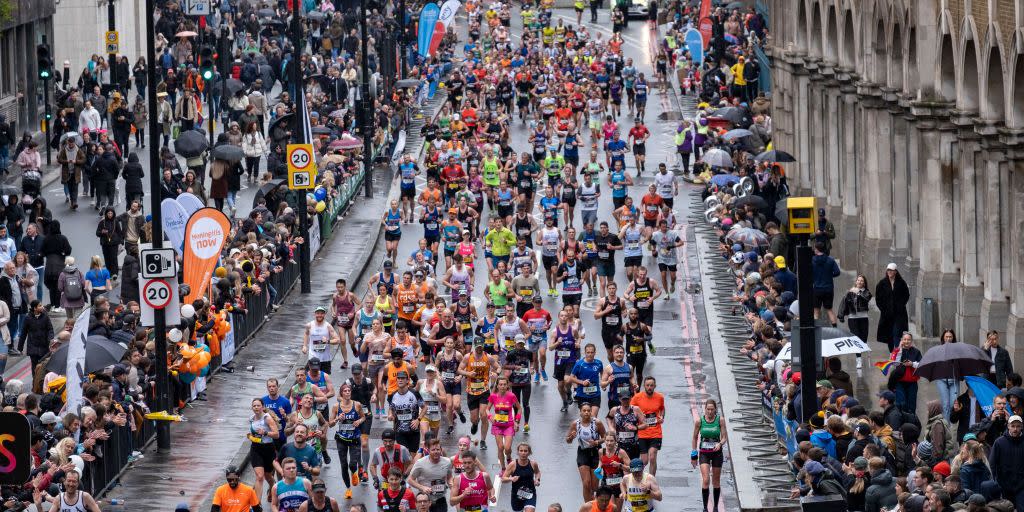10 biggest marathon mistakes – and how not to make them

RW editors Andy Dixon, Rick Pearson and Kate Carter are no strangers to the marathon. Andy and Kate are both Six Star finishers – meaning they’ve run all the World Marathon Majors – and all three have recorded sub-3 marathons (but don’t like to talk about it…). Kate’s CV also includes setting a world record for the fastest marathon while wearing a panda suit.
More pertinently, they’ve all made plenty of mistakes while training for and racing the 26.2-mile distance. And now they’ve distilled this hard-won wisdom into 10 pieces of advice every budding marathoner should read…
1. Not practising your fuelling strategy enough in training
On race day, you’re putting your body through more stress than you will have done on a training run, so it can be difficult to replicate that when it comes to testing your nutrition. If you’ve only taken gels on super, easy long runs, then you can still come a cropper on race day. Instead, make sure you trial taking gels while running at marathon pace. See if you can open the gels while running at that pace, too, which isn’t always easy.
2. Not trusting the taper
A classic marathon-training error. If your training has gone well and you get to the final three-week window before the race, you may get a bit antsy and feel the temptation to prove your fitness. But, ultimately, you’re not going to get fitter during this period, and attempting to cram in training sessions will do more harm than good. Heed the mantra: it is better to be 10% undertrained than 1% overtrained.
3. A lack of consistency in training
If you want to get better at running, the single most important thing you can do is be consistent. Whether it’s three runs a week or six runs a week, if you consistently stick to your training plan, you will see results. It’s not glamorous. It’s not a hack. It’s just true. And it doesn’t work if you cluster it: you can’t cram in a week’s worth of training into a weekend and expect the same results. Likely, you’ll just get injured.
4. Not doing enough strength and conditioning
The results of doing running-friendly strength and conditioning are not always visible: it’s usually motivated by a desire to avoid injury rather than to bag an invite onto Love Island. But it should nevertheless form part of every budding marathoners training week.
Marathons are a bodily battle: it’s often muscular fatigue that holds runners back in the final stages of a marathon, rather than aerobic fitness. For all those feeling slightly overwhelmed by strength and conditioning, follow Richard Blagrove’s advice on the 7 strength moves runners actually need.
5. Trying to make up time lost to injury
It’s a natural enough instinct: you’ve lost a week or so due to injury and you now want to make up for lost time. But it’s a false economy. Putting in too many quality sessions with not enough recovery is a recipe for re-injury. Be patient. Don’t try to force it. De-training doesn’t start immediately: you can miss two weeks with little to no consequence.
6. Going out too fast
We get it: the first few miles of a marathon are exciting. The pace feels easy (or should) and you can start wondering if you’ve underestimated how wonderfully fit you’ve become. Perhaps you should go faster than planned and see what happens? Alas, making hay while the sun shines is not a wise marathon-running tactic. It will end in pain, walking and a huge positive split. So, stick to your planned pace. Running the first 5km segment of a marathon 10% faster than race pace adds about 37 minutes to the average finish time.
7. Trusting your GPS watch rather than the mile markers
Marathon courses are not measured according to GPS; it’s measured by professionals, usually with a bike wheel. So don’t trust your GPS, particularly in city races when it may go haywire. Tunnels and tall buildings can get your watch pace out of whack. Consider turning off auto-lap on your watch, as it likely be clicking off the miles before you actually reach the mile markers. If looking out for every mile markers feels too stressful, consider using 5km splits (even when a marathon has mile markers, it will invariably have 5K, 10K, 15K, etc kilometre signs too).
8. Trying something new on race day
You should have tested everything that you’ll be using on the day: from kit to nutrition to pace. It can be easy to think a new pair of shoes may be the missing piece of the puzzle, or a snazzy new vest will make you feel faster on the day, but really any new purchase is an unnecessary risk. Get to the start line wearing only tried-and-tested favourites. Heed the mantra: nothing new on race day (apart from a PB).
9. Under fuelling
RW columnist and leading nutritionist Renee McGregor advises runners to ‘aim for 30-60g per hour for the first three hours of a marathon. And increase that to 60-90g for every hour after that.’ You can get these carbs from gels, sports drinks, jelly babies and more. For reference, 60g is between two to three gels, depending on brand. And keep your eye on hydration, too. Think: little and often.
10. Clinging to a time goal even if training has gone worse than expected
You’ve set your sights on a watermark time and you tell yourself you can still somehow pull it out of the bag, even though your training has been patchier than an eyepatch convention. It would be wise, however, to recalibrate your goal to a more realistic finish time. Because, rest assured, the marathon will find you out.
You Might Also Like


